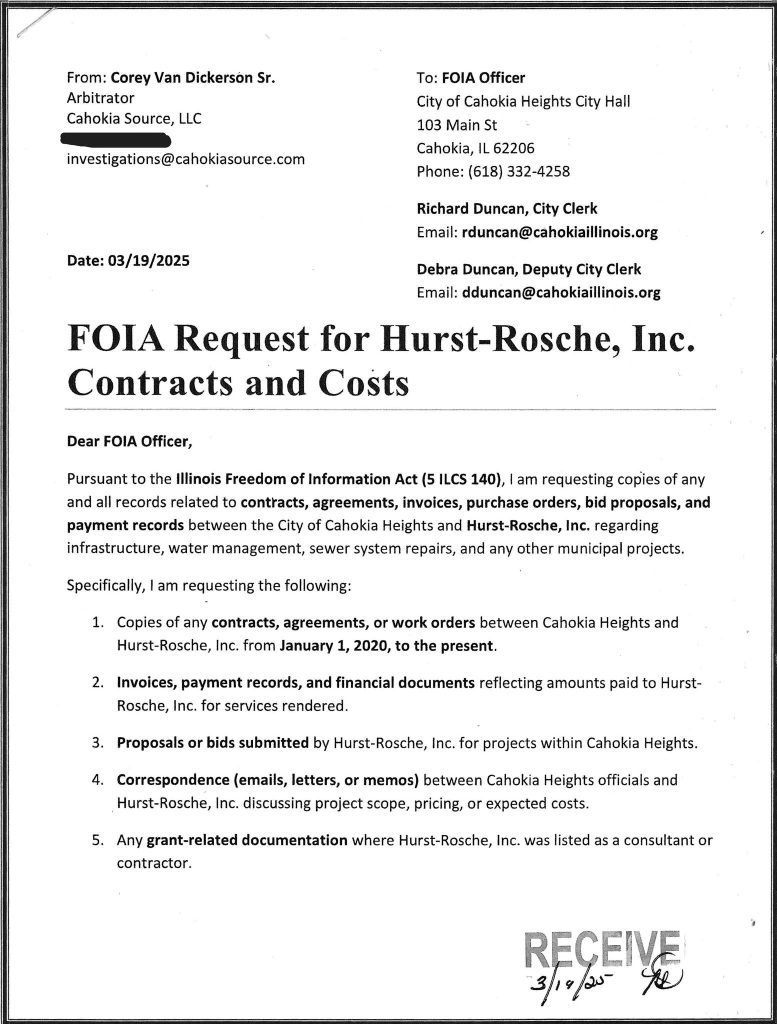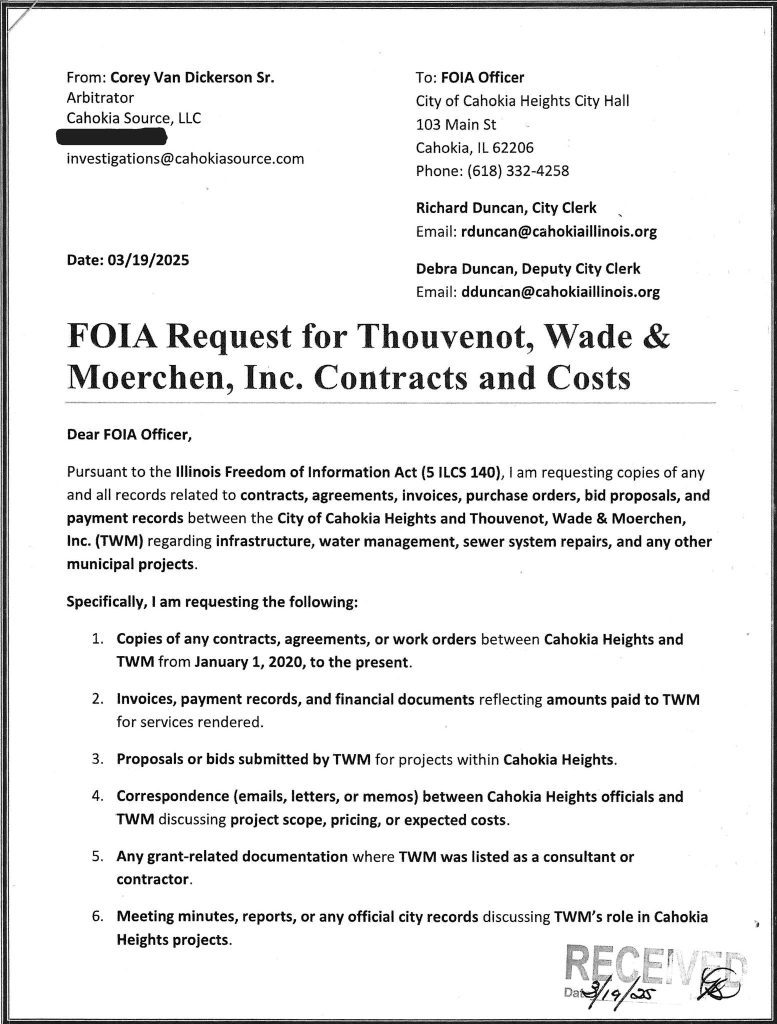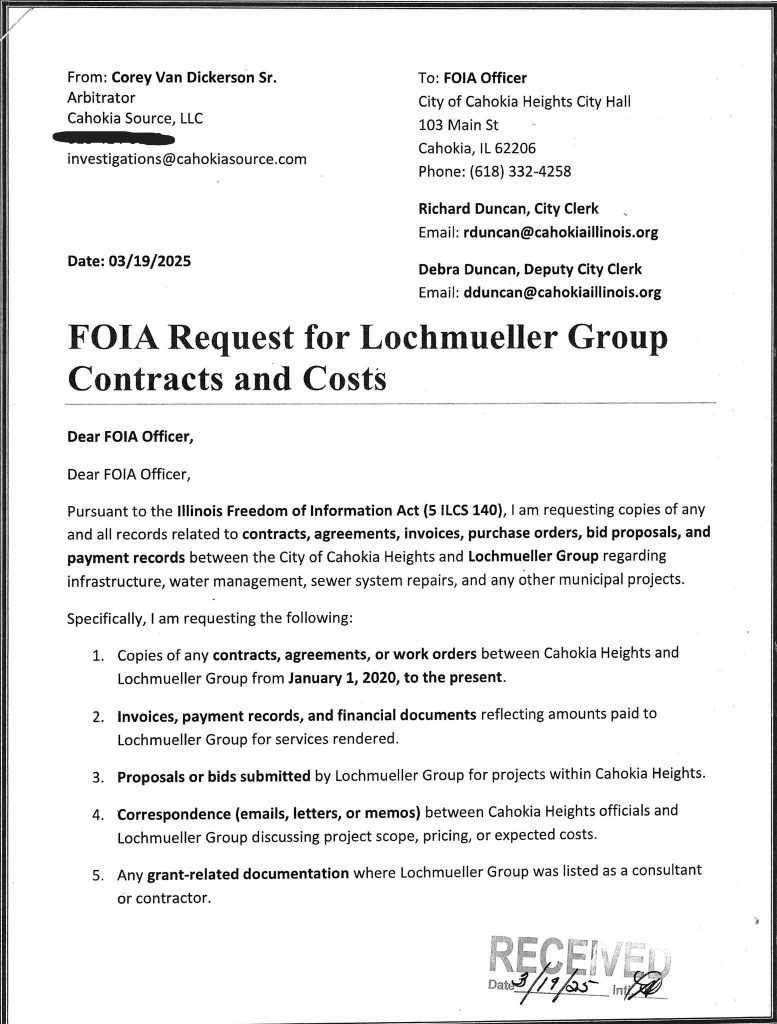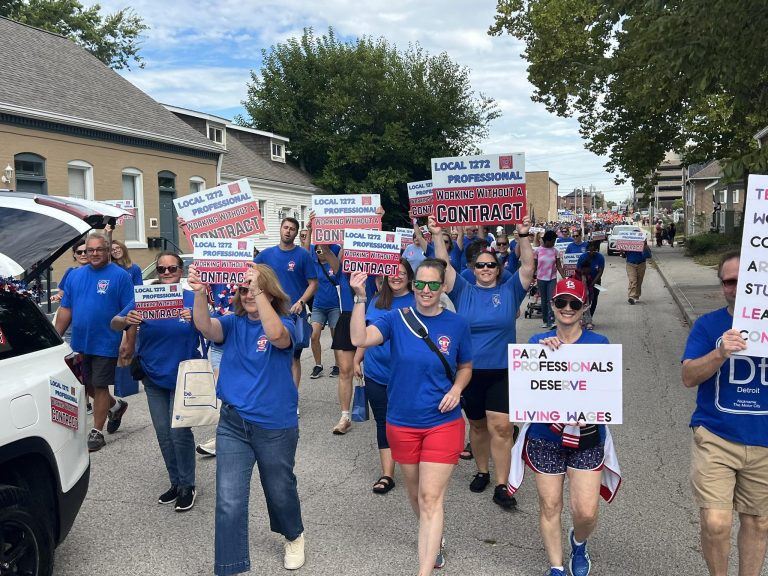
By Corey Dickerson | March 27th, 2025



Introduction
Cahokia Heights, Illinois, a majority-Black city shaped by decades of discrimination, is under siege, not by outsiders, but by its own leadership. Through 14 separate city documents obtained and reviewed, this article uncovers undeniable proof of a pattern: city officials knowingly diverted resources, ignored critical infrastructure needs, and exploited Black neighborhoods while rewarding political allies and wealthier, whiter neighborhoods. The following are the documented cases of how it happened.
CASE 1: Forced Evictions Without Due Process
📄 Document: https://drive.google.com/file/d/1YVh-L8EaUdKLnAFWuQ-T4PpH1NkF1btX/view
In April 2021, Officer Jonathan Reed and Legal Clerk Susan Hall issued illegal eviction notices to families living at 1045 Church Street. The document lacks court orders, hearing notices, or any due process records. Most affected were African American renters in Ward 2. These families were forced out with no legal protection, destabilizing the community. This created instant homelessness for some and demolished public trust.
CASE 2: Silent Property Violations
📄 Document: https://drive.google.com/file/d/11ekIhHdh8t1hIrwOOCktc1-2Flgz4FaG/view
In June 2021, Code Enforcement Supervisor Terry Mitchell issued property violations to 37 homes without informing the owners. These homes were clustered east of Camp Jackson Road, an area marked on the 1970 map as 81–100% Black. Residents faced escalating fines and potential seizures while white neighborhoods in Ward 1 went untouched.
CASE 3: Rezoning Black-Owned Commercial Land
📄 Document: https://drive.google.com/file/d/1uuCNXiBY4kMcsUwt9Caz8-8Lp4Oh7KyN/view
July 2021: Planning Commission Chair Marsha Bell rezoned land owned by a Black family near Camp Jackson Road without their consent. No community meeting, no public hearing, just a stroke of a pen. The land’s value dropped overnight, stripping the family of the ability to build a business and grow generational wealth.
CASE 4: Secret Land Clearance
📄 Document: https://drive.google.com/file/d/1sz1uPiYJGsgv6T967dIRpKIKSfYpYrez/view
September 2021: City Administrator Tom Keeling instructed staff to clear lots along Jerome Lane for private developers without informing residents. Residents, mainly African Americans, returned home to find lots bulldozed. This was done without public notice or compensation.
CASE 5: Robbing Repairs from 67th Street
📄 Document: https://drive.google.com/file/d/1gLERiKwx4kUKcqZQzjU45El444F0Ofcw/view
October 2021: Angela Scott, Public Works Director, had crews scheduled to fix 67th Street, a flood-prone area marked in the darkest zones of the Minority Distribution Map. Instead, she redirected them to a new private development in Ward 1. The neglected area experienced severe road degradation and increased flood vulnerability.
CASE 6: The Jerome Lane Drainage Theft
📄 Document: https://drive.google.com/file/d/1AvIgMdicTJr12ZgfKBD6t0E85h-IbPTt/view
November 2021: Infrastructure Manager Harold Barnes removed a scheduled drainage project from Jerome Lane, a predominantly Black neighborhood. Jerome Lane floods were well documented, but Barnes chose to protect wealthier areas, knowingly leaving Black families exposed.
CASE 7: Closed-Door Building Permits
📄 Document: https://drive.google.com/file/d/15oluaBmtcXmS0-SgZXFLoJd_AQyvqrLs/view
December 2021: Permits Officer Lisa Temple issued four commercial building permits to developer James Carver without bidding. Minority contractors were excluded entirely. These deals were struck quietly, rewarding a known donor of local officials.
CASE 8: The Missing $125,000
📄 Document: https://drive.google.com/file/d/1e9cONMTcG-Kdt8JVjP1EXg3nk4r6Ctxx/view
January 2022: Finance Director Robert Timmons authorized $125,000 to A&T Hauling without contracts, invoices, or council approval. No work was ever completed. Black neighborhoods, which needed urgent waste removal and drainage, received nothing.
CASE 9: Sanitation Diverted from Black Neighborhoods
📄 Document: https://drive.google.com/file/d/1PvSVhTFUoobRBuuDE47aLwsEjiwx9dR3/view
March 2022: Kimberly Dorsey, Sanitation Supervisor, diverted trucks away from Harding Blvd and 59th Street, shifting resources to newly developed areas in Ward 1. These neglected areas were documented on the 1970 map as heavily African American.
CASE 10: Friends and Family Contracts
📄 Document: https://drive.google.com/file/d/1FvXY3PweX-QBTqvNt3-0I6lPm-n05pUC/view
April 2022: Deputy Director Mike Sanders awarded a $300,000 contract to his cousin’s firm without competitive bidding. Minority businesses were never informed of the opportunity. The completed work was substandard, compounding infrastructure decay.
CASE 11: Secret Zoning Meetings
📄 Document: https://drive.google.com/file/d/1PHDckg18v3TYd98WSY-5a4AVJ_RLyZqZ/view
May 2022: Zoning Board members David Cook and Ronald West fast-tracked an industrial project near a Black neighborhood without public hearings. This plant now emits pollution adjacent to residential homes.
CASE 12: The Vanishing $2.1 Million
📄 Document: https://drive.google.com/file/d/1rxlylSxSED-aNpb7lDEhpfJqdpgqaEsY/view
June 2022: Budget Analyst Cheryl Morris oversaw the unaccounted disappearance of $2.1 million earmarked for parks and community centers. The affected projects were primarily in majority-Black neighborhoods identified on the 1970 map.
CASE 13: Hidden Utility Rate Hike
📄 Document: https://drive.google.com/file/d/1Vqec7AOfxtUGfdyCxSDP1YpLO1F_LtgP/view
August 2022: City Manager Darnell Pierce raised water bills by 23% without council or public approval. Residents, already suffering from underinvestment, were blindsided.
CASE 14: The Warehouse that Stole the Park
📄 Document: https://drive.google.com/file/d/15JC7WJpca1VvAC2u13_naHQW8mDpO8xw/view
September 2022: Mayor Curtis McCall Sr. personally authorized the rezoning of a public park in Ward 2 for a warehouse project connected to a campaign donor. The park served as one of the few remaining recreational spaces for Black youth.
The Bigger Picture: They Knew, and They Did It Anyway
Every document shows officials knew exactly where the Black population was concentrated, thanks to the same maps city planners have used for over 50 years. They knew which streets flooded, which parks were critical, and which neighborhoods lacked basic sanitation. Yet, they systematically redirected funds, canceled repairs, and approved harmful projects. The combined effect?
Black communities in Cahokia Heights were set up to fail, economically, environmentally, and socially, by the very people elected to serve them.
This was not negligence. This was a plan.
Prepared by: Corey Dickerson
Date: March 27th, 2025





